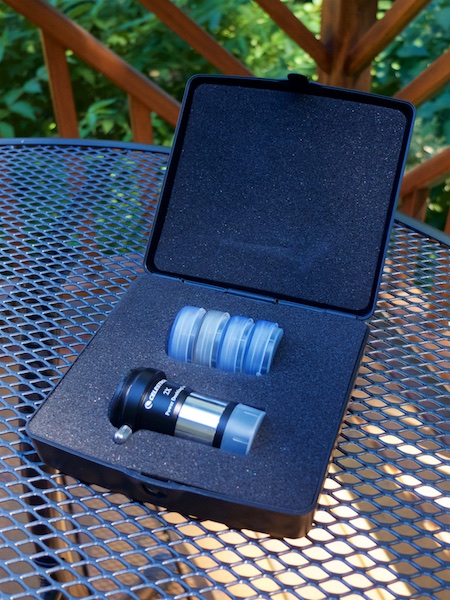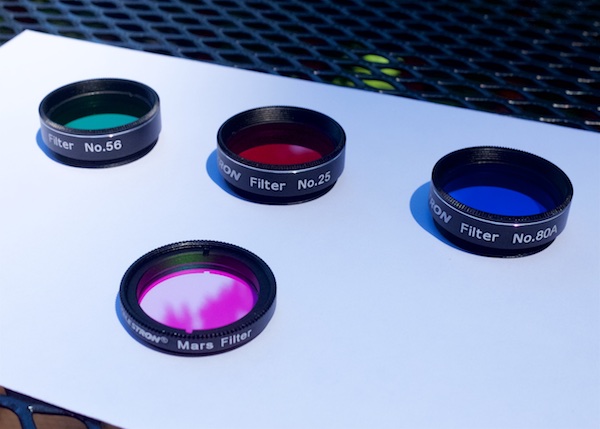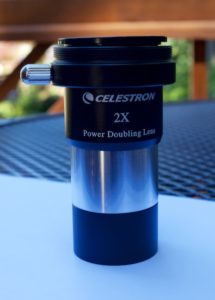When it comes to astronomy, let’s just say that I’m still learning. I’ve made some good progress with the Moon, and I’m learning to identify the brightest stars, but when it comes to anything much more complex than that – variable stars, nebulae, deep anything – I’m, as they say, “not quite there yet.”
However when I heard about the upcoming Mars Opposition and how it was expected to be one of the best in many years, making the red planet the brightest object in the night sky (after the Moon, of course), well… observing this, I thought, would be within my reach. And with this new little filter kit Celestron is producing specially for the event, I should be able to see some impressive details on the planet even with the relatively simple telescope I use.

First, however, just what is the Mars Opposition? The “opposition” in the name refers to the fact that Mars and the Sun will be on directly opposite sides of the Earth. This is something that happens approximately every twenty-six months; however every fifteen to seventeen years (give or take), the position of Mars during the opposition is at the closest point in its orbit to the Sun, meaning that it is also at a very close (relatively speaking, of course) point to the Earth. NASA has a very helpful web page all about it if you’d like to learn more.
Right. So then when I first heard about this upcoming planetary event, I did what I always do when discovering some previously unknown phenomena – I sought out a book on the subject. Curiously, unlike last year’s North American total solar eclipse, there hasn’t been a wave of new books published about Mars. In fact, there aren’t really all that many books about Mars new or old. Fortunately, Princeton University Press just happened to have a new book that published last month: Life on Mars; What to Know Before We Go by Dr. David A. Weintraub. It’s a very helpful book indeed on getting “up to speed” with the history of Martian astronomy and the discoveries that have been made about it as a result. It also helped me to gain a better understanding of what to look for when observing Mars and how to understand what I see when I’m looking at it.
Which takes us back to the topic at hand: Celestron’s Deluxe Mars Observing Telescope Accessory Kit. This handy little set of four filters and a 2x doubling lens is something anyone interested in observing not only the upcoming Mars Opposition should have to hand, but anyone interested in getting the most out of any astronomical observations for that matter. Even if you don’t have a particularly sophisticated telescope (mine, for example, is a very straight-forward Celestron Inspire 70 AZ Refractor), the addition of enhancing filters to the eyepiece can make a world of difference when observing… well, other worlds.

The kit contains four 1.25″ (the most common astronomical eyepiece diameter) filters, three you’d likely find in any good observing accessory kit and one specifically created for making observations of Mars:
- #80A Light Blue Planetary Filter: brings up details in surface features on planets (and makes observing the Martian polar ice caps easier).
- #56 Green Planetary Filter: Greatly increases the contrast of the Martian polar caps, as well as clouds and the yellowish dust storms Mars is prone to.
- #25 Red Planetary Filter: Darkens the maria and oases by reducing the intensity of the areas on the surface that reflect blue or green; also highlights the orange Martian desert region.
- Mars Filter: A single filter that combines the strengths of the red and the blue filters while minimizing the loss of light that might be caused if you stacked those two strong filters together for use.

Also included is a 2x doubling lens that (can you guess?) doubles the strength of any eyepiece added to it. Simply position the doubling lens between the telescope’s eyepiece mount and the eyepiece itself and you’ve got twice the magnification to make your observations. This little item is also very helpful in a number of other observing situations, including terrestrial ones such s bird watching, whale watching from on-shore vantage points, and telephotography. So long as your telescope or spotting scope accepts 1.25″ astronomical-style eyepieces, you’re “good to go.”
All these items come packaged in a nice little padded, hard-shell case that makes them easy to store as well as easy to carry. As astronomy is more of a position-centered activity than most other natural history pursuits, carrying items isn’t always so much of a problem, but keeping all the bits and bobs that can become involved at higher levels of its practice organized most certainly is – so having a well-designed regular home for your smaller bits of kit always makes life easier whatever your level.
Now, some more experienced observers may already have a set of planetary filters and a doubling lens (they are fairly common astronomy kit), so Celestron also sells the Mars Filter itself as a separate item for those who only want that particular filter. There is also, for those looking to save a few farthings, a standard Mars Observing Telescope Accessory Kit that contains all the items in the Deluxe Kit except the Mars Filter (remember, the red and blue filters can be stacked for a similar effect, only the resulting image may be a bit darkened by the additional glass of two filters together).
The Mars Opposition of July 2018 promises to be one of the best opportunities for as close a look at the red planet as any amateur astronomer has had in years, or will have for some years to come. Even if you only have a simple telescope that you’ve never really done much with, so long as it has a 1.25″ eyepiece (which most you’ll regularly encounter do), getting it out for this will be well worth the trouble. And as enhancing your view is as simple as screwing on one of these helpful filters, you really owe it to yourself – and especially your children or students, if such you have – to make the most of this close-up opportunity. You’ll also find that having these filters around can make other observations more interesting by showing greater detail of your subjects. Try them out on Jupiter or Saturn. Have a look at the Moon with them. Experiment. Have fun. Sometimes the most surprising discoveries come when you’re “just playing.” That’s really what amateur nature study is supposed to be all about anyway.
If you enjoyed reading this, please consider signing up for The Well-read Naturalist's newsletter. You'll receive a helpful list of recently published reviews, short essays, and notes about books in your e-mail inbox once each fortnight.
